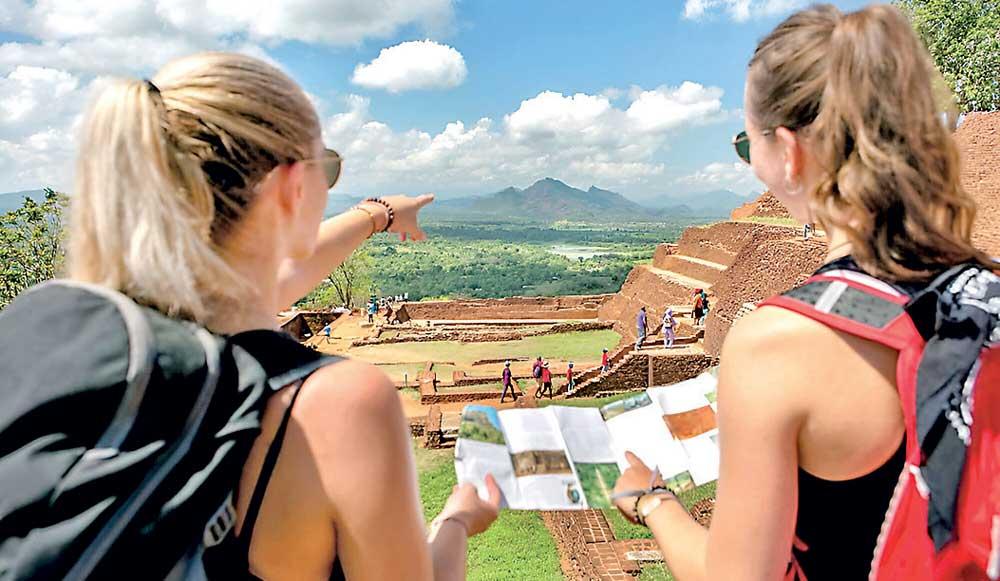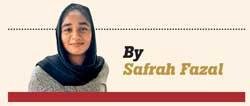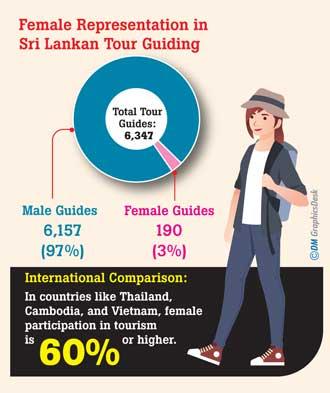24 Sep 2024 - {{hitsCtrl.values.hits}}

According to the latest data, as of May 2024, Sri Lanka’s tour guiding industry comprises approximately 6,157 male guides and just 190 female guides, showcasing a stark gender imbalance
 While gender disparities in various professions are gradually narrowing — albeit at a snail’s pace — there remains a glaring gap in one field: tour guiding. According to the latest data, women make up less than 10% of Sri Lanka’s tour guides. It’s particularly ironic that Sri Lanka was named the top destination for solo female travellers in 2024 by Timeout.com, a global media and hospitality company. Whether this ranking is up for debate — as many immediately did — is another matter entirely.
While gender disparities in various professions are gradually narrowing — albeit at a snail’s pace — there remains a glaring gap in one field: tour guiding. According to the latest data, women make up less than 10% of Sri Lanka’s tour guides. It’s particularly ironic that Sri Lanka was named the top destination for solo female travellers in 2024 by Timeout.com, a global media and hospitality company. Whether this ranking is up for debate — as many immediately did — is another matter entirely.
|
Farhana Hassim
|
|
Tharanga Manoj Maddage
|
|
Sanjika Hengst-Mendis
|
|
Srilal Miththapala
|
The under-representation of female tour guides was highlighted in a recent report titled ‘Comprehensive Study of the Sri Lankan Tourist Guides: Focusing on Enhancing the Skills of Tour Guides’. This study, considered to be the first-of-its-kind, was initiated by Skills for Inclusive Growth, a bilateral programme between the governments of Australia and Sri Lanka, and carried out by Survey Research Lanka in collaboration with the Sri Lanka Tourism Development Authority.
Female Representation at just 9%
According to the latest data from the survey, as of May 2024, Sri Lanka’s tour guiding industry comprises approximately 6,157 male guides and only 190 female guides, showcasing a stark gender imbalance.
The survey of 300 respondents underscores that tour guiding remains a male-dominated field, with women representing only 3% of National Guides (who provide guidance across the country), 10% of Area Guides (those who specialise in specific geographical regions within Sri Lanka) and Site Guides (those who focus on specific sites or attractions within the island), and 0% in the Chauffeur Guide category (those driving tourists to various locations while also offering insights into local attractions and culture). Female representation is minimal across all categories, despite these women being highly skilled and effective in their roles.
The study’s qualitative research also found that female tour guides offer distinct strengths, such as strong communication skills, empathy, and the ability to forge personal connections with tourists. Many excel in niche markets. However, cultural barriers, safety concerns, and late working hours remain significant challenges to their participation in the profession.
To understand the realities of being a female tour guide in Sri Lanka, Daily Mirror spoke with three women who have been in the profession for several years.
Challenging misconceptions
Meena Vijayakumara*, a National Tour Guide with over 15 years of experience, highlighted a persistent misconception about the profession. “Since the beginning, Tour Guides have been associated with ‘Beach Boys,’ who not only guide, but also involve tourists in their personal lives. Families assume we do the same. This perception hasn’t changed. People still view tour guiding as a man’s job, unsuitable for women.”
Echoing similar concerns, Sanjika Hengst-Mendis, a National Tour Guide since 2017 said that society doesn’t understand how they (female guides) work. “There’s a negative impression, likening us to ‘Beach Boys,’ which is completely wrong. We provide tourists with an authentic experience of Sri Lanka and act as unofficial ambassadors of our country,” she added.
Farhana Hassim, an Area Tour Guide in the Central Province for nearly a decade, noted that some level of gender discrimination exists in this profession, as it does in many others. “When tourists request specialised tour packages like bird watching, jungle visits, hiking, or rafting, it’s rare for female guides to be selected. There’s a misconception that we can’t handle these types of tours, which is simply untrue,” claimed Hassim.
Similarly, Tharanga Manoj Maddage, former President of the Sri Lanka Institute of National Tourist Guide Lecturers, pointed out that there is a prevailing belief that men are inherently more capable than women in handling adventure tours like trekking, hiking, rafting, or snorkelling. “In European countries, women are often at the forefront. We must prioritise opportunities for females in our country and increase their representation in this field,” he stated, emphasising the need for a mindset shift in Sri Lanka.
The need to be ‘tough’ to survive
Having worked in the field for over 15 years, Vijayakumara recounted her experience of being harassed by some male tour guides; particularly during her early years. She faced snide remarks and rumours suggesting she provided services beyond the scope of tour guiding. “When we receive back-to-back work and are recommended by companies, some male guides don’t appreciate it. While there are many efficient guides, some opt for shortcuts; these people try to tarnish our reputation with false stories. It’s been a challenging journey for me, and I’ve had to be tough to survive in this field,” she claimed.
On the other hand, Hengst-Mendis shared that she has never personally experienced harassment or discrimination, though she has heard that some other female guides have. “Some people call me a male guide because no one tries to be funny with me. I have never been bullied. You have to be tough as a female tour guide, as you often interact with hotel managers, security personnel, and others in the industry. Even while leading your group, you may encounter rude remarks, and you need to know how to handle it. Some believe that harassment only comes from fellow tour guides, but that’s not the case. Being tough is essential in this field. If you let things unsettle you, this isn’t the right profession for you. You need to stand firm as a woman, and then you won’t face issues,” she emphasised.
Challenges in accommodation
A critical issue that jeopardises the safety of female tour guides and limits their opportunities is accommodation during round trips. When guiding smaller groups of 6-7 people, companies often hesitate to cover the costs of lodging for tour guides although some provide cash for accommodation outside the hotel. While male guides can find dormitory-style accommodation in some hotels, female guides face challenges, as these dorms are predominantly occupied by men. This often forces them to seek alternative accommodations late at night.
“Tour companies must allocate a room for the guide during tours and provide transportation; however, finding safe accommodation during peak periods is difficult. Many hotels do not offer lodging for guides at peak times, making it less likely for companies to choose female guides,” Hassim emphasised.
With work on each day during most tours concluding around 6 p.m, Hassim noted that female guides face significant challenges in securing safe and suitable accommodations, particularly in rural areas. “Even if companies provide funds for lodging, suitable accommodation is hard to find, and the timing makes it even more difficult,” explained Hassim.
Vijayakumara recalled times when she had to search for accommodation at midnight, often breaking down in frustration when suitable options eluded her. “Some hotels have dormitory-style accommodations for male guides, but not for females. We often have to search for rooms late at night; sometimes far from where the tourists are staying. This is still a reality today,” she said.
Meanwhile, Hengst-Mendis stated that she refuses any tours that do not guarantee accommodation at the same hotel as her guests. “I’ve experienced situations where my guests fell ill in the middle of the night. If I’m staying elsewhere, I would have to find a way to return, which is highly inconvenient. If a company hires a female tour guide, they should provide a room at the same hotel. I won’t accept tours where I have to find separate lodging. Those are my conditions, though I know others have complained about this issue,” she complained.
Maddage stressed that the cheap tourism practices employed by some travel agents contribute to the low percentage of female guides. By hiring male guides, travel agents can provide cheaper accommodation outside the hotels where the tourist group stays. If female guides are placed in accommodations away from the group, their safety can be compromised. “In the German market, the tour leader is always female, and many women work as tour guides or leaders there, receiving the same accommodations and amenities as the tourists,” Maddage noted, highlighting the greater representation of females in the tour guiding field in Europe.
Cultural Barriers to female participation
Hengst-Mendis pointed out that cultural expectations surrounding marriage and family responsibilities significantly deter many women from entering or remaining in the tour guiding profession. “Tours can last anywhere from two to twenty days; which means a guide is away from home for extended periods. When children are involved, the burden of family responsibilities often falls on women. This is why many women hesitate to join this field or choose to leave it early,” she explained.
She added that some women who initially enter the profession often exit when discussions about potential marriage arise.
Hassim underscored the fact that the need to visit sites and return late poses challenges for many women. In the case of round tours, where guides travel with tourists across various destinations, being away from home for days can be particularly concerning for their families, regardless of whether the guide is married or single. “Cultural and religious restrictions further complicate matters for some women entering this profession. Culture often holds beliefs that women need protection and security, leading many to view tour guiding as an insecure job,” she said.
Vijayakumara noted that traditional gender roles also keep women at home. “Male-headed families often prefer women to remain at home or to work as Area or Site Guides; allowing them to return home at the end of the day,” she emphasised.
Retaining women in the field
 “Overall, there is a very poor female participation in the tourism industry; whereas in countries like Thailand, Cambodia and Vietnam, it is at almost 60% or more,” stated Srilal Miththapala, Tourism Consultant for the Asian Development Bank and former President of the Hotels Association of Sri Lanka. He noted that the low representation of women in both the hotel and tour guiding sectors is compounded by a pervasive culture of ‘male chauvinism’ that deters women from entering these fields. “This is a social issue and has nothing to do with tourism. Our society remains somewhat old-fashioned. Addressing it will be challenging and must begin at the grassroots level. Awareness needs to be raised among parents, communities, and religious leaders,” he said.
“Overall, there is a very poor female participation in the tourism industry; whereas in countries like Thailand, Cambodia and Vietnam, it is at almost 60% or more,” stated Srilal Miththapala, Tourism Consultant for the Asian Development Bank and former President of the Hotels Association of Sri Lanka. He noted that the low representation of women in both the hotel and tour guiding sectors is compounded by a pervasive culture of ‘male chauvinism’ that deters women from entering these fields. “This is a social issue and has nothing to do with tourism. Our society remains somewhat old-fashioned. Addressing it will be challenging and must begin at the grassroots level. Awareness needs to be raised among parents, communities, and religious leaders,” he said.
Miththapala acknowledged that while bridging the gender gap in the tourism industry is a significant challenge, some larger companies and agencies are taking initiatives to address it. “Change won’t happen overnight. We need to set small, achievable goals. If the current female participation as tour guides is at 3%, let’s aim for 10%, and then actively work toward that target,” he explained.
The female tour guides interviewed by Daily Mirror echoed this sentiment, emphasising the need for greater awareness about the role of tour guides. While urban populations tend to have a better understanding of the profession, those in rural areas are often unaware; limiting opportunities for local women who would be well-suited for positions as Area or Site guides.
“The newcomers should know that this is a secure field,” Hengst-Mendis remarked. “It’s essential to convey that they won’t be misused or bullied. At the same time, they need to learn to stand up for themselves,” she said.
(*Name changed upon request)
24 Dec 2024 14 minute ago
24 Dec 2024 1 hours ago
24 Dec 2024 2 hours ago
24 Dec 2024 3 hours ago
24 Dec 2024 4 hours ago